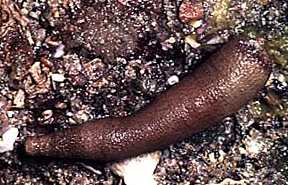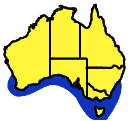|
|

Peanut Worm, Phascolosoma noduliferum
Form:
 The
Peanut Worm has a flask-shaped, almost cylindrical
body, which is pointed at the front end.
The
Peanut Worm has a flask-shaped, almost cylindrical
body, which is pointed at the front end.
When resting, its body is normally introverted, like a finger on a glove turned in on itself. But when seeking prey, the animal can extend itself rapidly. The mouth, mandibles and feeding tentacles are at the front end of this extrovert. See worm feeding.
The Peanut Worm's body lacks segmentation but is covered with fine granules.
Colour:
Its colour is brown to light-brown, slightly darker at the ends.
Phylum: |
Sipuncula |
Author: |
Stimpson, 1855 |
Family: |
Sipunculidae |
Size: |
12 - 65 mm |
Distribution:
 The
Peanut Worm ranges from Port Stephens, in N.S.W. around the southern shores
to Hopetoun, in Western Australia, and around Tasmania.
The
Peanut Worm ranges from Port Stephens, in N.S.W. around the southern shores
to Hopetoun, in Western Australia, and around Tasmania.
Habitat:
It occurs on sheltered and moderately exposed reefs at low tide levels and below to 1500 metres. It is usually found under stones embedded in sand or gravel, or in Galeolaria tube-worm colonies.
References:
Bennett, I. (1987) W.J. Dakin's classic study: Australian Seashores. p.198, Angus & Robertson, Sydney.
Davey, K. (1998) A Photographic Guide to Seashore Life of Australia. p.39, New Holland, Sydney.
Edgar, G.J. (1997) Australian Marine Life: the plants and animals of temperate waters. p.163-4, Reed Books, Kew.
Eunice
Bristle Worm
Galeolaria
Scale Worm
Peanut Worm
Home
Page
Taxonomy
Biogeography
Rocky Shores
Tidal Levels
Intertidal Zonation
Environmental Factors
Biological
Factors
Feeding Relationships
Activities
Glossary
References
 Life
on Australian Seashores
Life
on Australian Seashores
by Keith Davey (C) 2000
Learning Consultant
- Media
The University of Newcastle
email at australian_seashores@hotmail.com
Scientific Consultant: Phil
Colman
site created 01.01.98 : updated 01.04.2000